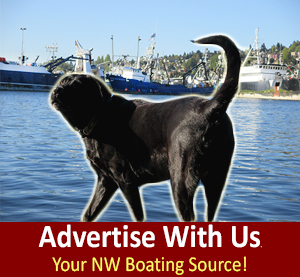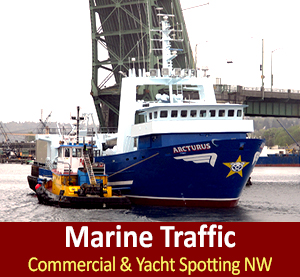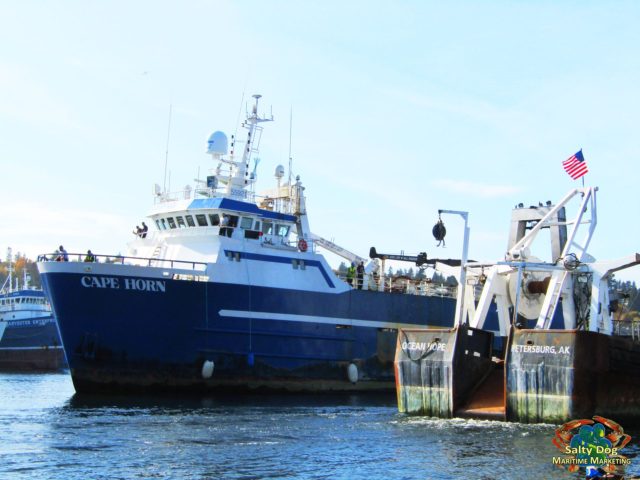
F/T Cape Horn, Iqiuque US Fisheries Homecoming, F/V Ocean Hope, heads over to Pacific Fishermen Shipyard to go dry on the ways, Commercial Fishing Boat Photography By: Salty Dog Boating News, Salty Dog Maritime Marketing, Commercial Fishing, PNW to Bering Sea AK Marine Traffic Underway Source, The All Season Fall Pulse PNW
F/T Cape Horn, 158 ft. Iquique US, fishery for cod, flatfish and rockfish; making her way eastbound in the WA Ship Canal getting a few bridge lifts on her fall warm afternoon homecoming in the Pacific Northwest. Iquique is one of the seven member companies of Alaska Seafood Cooperative that was formed back in 2008 to ensure the flatfish fisheries that are operating remain well managed and are sustainably harvested, for present and future fisheries.
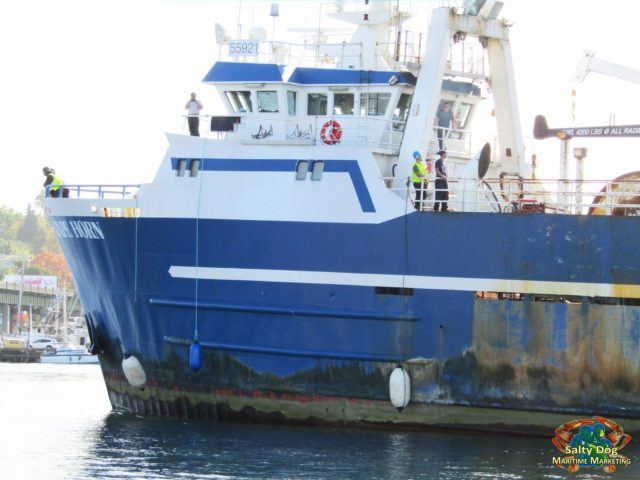
F/T Cape Horn, Alaska Seafood Cooperative, Iquique US, Ballard Bridge Lift, Fall Canal Homecoming PNW, Commercial Fishing Boat Photography By: Salty Dog Boating News, Salty Dog Maritime Marketing, Commercial Fishing, PNW to Bering Sea AK Marine Traffic Underway Source, The Pulse Pacific Northwest Commercial Marine Traffic PNW
F/T Cape Horn, sister vessels in the fleet include F/T Arica, F/T Rebecca Irene, F/T Unimak, these vessels are known as at-sea ‘catcher/processors’. They catch groundfish, sort by specie, take the heads off and guts out, pack the fish into pans, then they are frozen in horizontal contact plate freezers to a temperature of -20 deg C – or lower for some species. The finished product is stored on board in the freezer hold until the trip is over. Trips last between 5-7 days. These vessels produce between 40,000 to 45,000 metric tons per year, this is the selling weight – in dollars, it’s a good chunk of change in the millions.
Commercial Fishing Boat Photography By: Salty Dog Boating News, Salty Dog Maritime Marketing, www.saltydogmaritimemarketing.com You’re Commercial Fishing, PNW to Bering Sea AK Marine Traffic Underway Source, The Pulse – Stay Connected: [email protected] God Bless our Fisheries, Fisherwomen, Fishermen and their families on land and at sea!
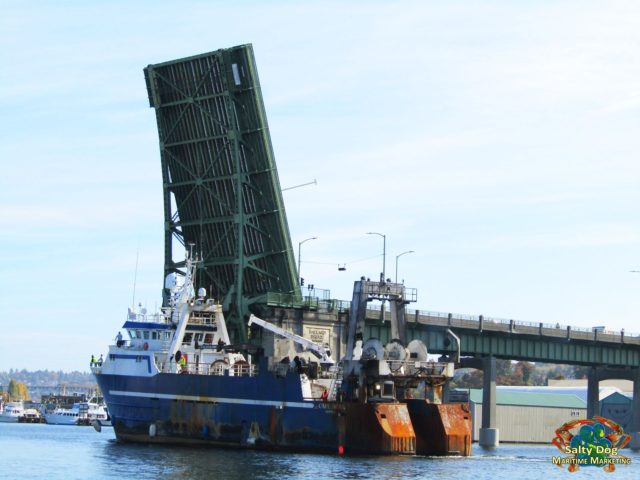
F/T Cape Horn, Catch Processor, Iquique US, WA Ship Canal Bridge Lift Eastbound Fall PNW, Commercial Fishing Boat Photography By: Salty Dog Boating News, Salty Dog Maritime Marketing, Commercial Fishing, PNW to Bering Sea AK Marine Traffic Underway Source, The Pulse AK to PNW
Iquique vessels spend a lot of time in Alaska’s Bering Sea -using Flatfish Trawl Gear when targeting sole and flounders. This modified gear principally uses sweeps raised off the seafloor by bobbins spaced at 30 meter intervals to herd flatfish into relatively small nets where the fish are captured. Research by NMFS scientists has shown that use of higher sweeps dramatically reduces effects of fishing on seafloor habitat and associated species such as crab and structure-forming animals called epifauna. This fishery brings some speculation about seafloor long term effects. Iquique’s vessels are all a part of the Alaska Seafood Cooperative, formed in 2008 under Amendment 80 regulations. They are known as “A80” boats. They operate year ‘round from January 20th into December of each year. It’s an active forever changing hard-core, mother nature’s in charge fishery.
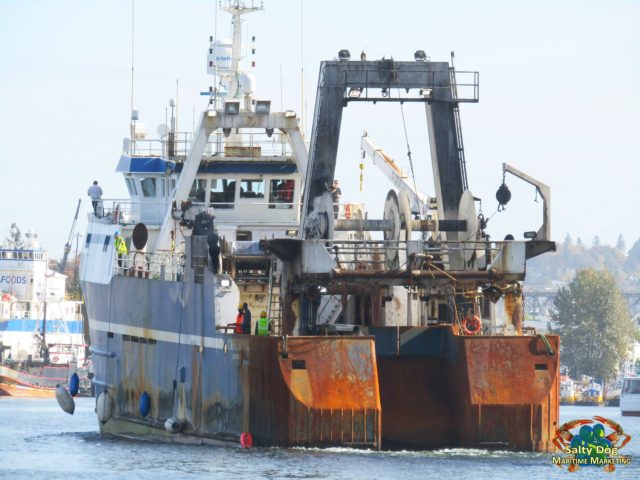
F/T Cape Horn, Iquique US, Alaska Seafood Cooperative, AKSC, Ending The Race for Fish, Commercial Fishing Boat Photography By: Salty Dog Boating News, Salty Dog Maritime Marketing, Commercial Fishing, PNW to Bering Sea AK Marine Traffic Underway Source, The Pulse PNW to AK
Iquique US, is like most seafood companies that take pride in the harvest of natural wild fish, while working to keep up an environmental balance that will keep our oceans healthy and productive for years to come. Per maritime fisheries standards, there is a usual for a collaborative effort between fishermen and scientists. Iquique and other producers, aboard the Alaska Seafood Cooperative, AKSC – worked to change gear to use sweeps raised off the seafloor to cut the effect of fishing on the seafloor and its habitat. They have a commitment to the balance and productivity of the ocean floor habitat and natural resources.
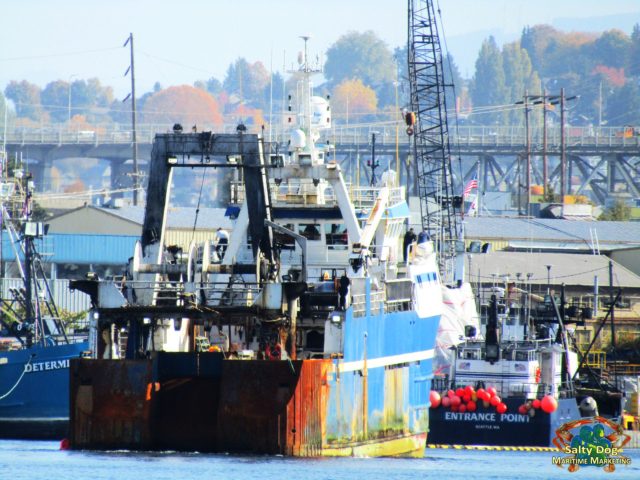
F/T Cape Horn, passing Silver Bay Seafoods and Trident Seafoods, Trident Old Yard, WA Ship Canal, Fall Afternoon, Commercial Fishing Boat Photography By: Salty Dog Boating News, Salty Dog Maritime Marketing, Commercial Fishing, PNW to Bering Sea AK Marine Traffic Underway Source, The Pulse PNW
F/T Cape Horn, makes her way eastbound up the canal after her Ballard Bridge lift she cruises by a fleet of Silver Bay Seafoods and Trident Seafoods fishing vessels; next up is the Fremont Bridge lift before entering Lake Union on a beautiful warm day. Fall in the Pacific Northwest means lots of shipyard action and vessel repairs, per usual getting ready for the next fishing season.



